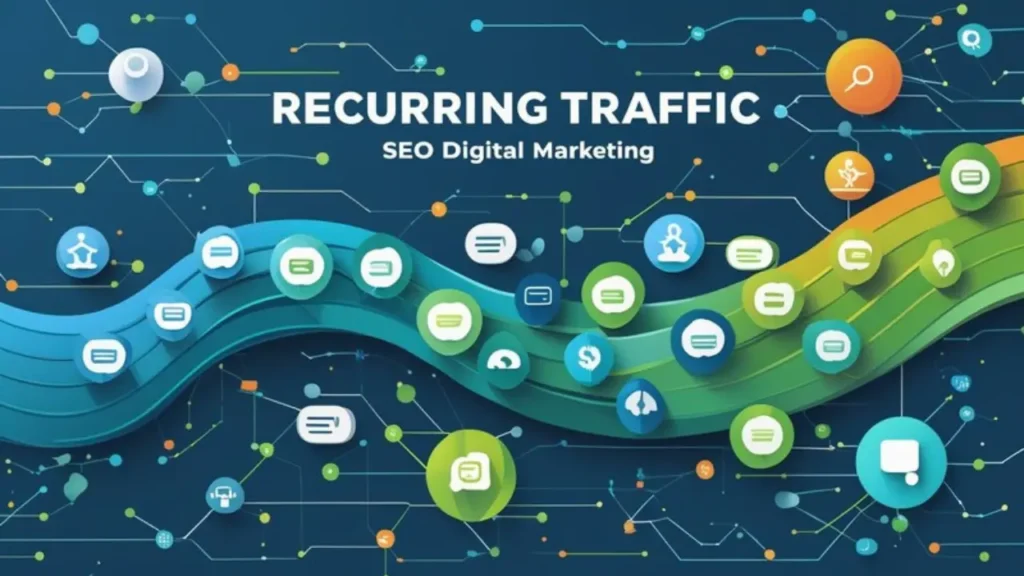Introduction
Every website owner dreams of building a steady flow of visitors who keep coming back again and again. Unlike paid ads, which stop delivering traffic once the budget runs out, recurring traffic creates long-term growth, higher brand trust, and better conversions.
The key to success lies in smart blog traffic strategies—balancing evergreen blog content with trending topics, optimizing for SEO, and creating content that readers want to revisit or share. In this article, we’ll explore proven strategies for blogs that drive recurring traffic, along with blog ideas that can pull frequent traffic, helping you increase website visitors consistently in 2025
Why Recurring Traffic Matters
Recurring traffic means more than just numbers—it’s about creating a loyal audience that trusts your brand. Here’s why it’s so important:

- Predictable growth: With recurring traffic, your website doesn’t rely only on one-off campaigns.
- Higher engagement: Returning visitors spend more time, engage more, and convert better.
- SEO advantage: Google rewards websites with consistent user engagement and fresh updates.
- Authority building: Blogs that provide value consistently become industry references.
👉 Example: A blog post like “Best Free SEO Tools” can attract thousands of visitors every year because people keep searching for updated lists of tools.
Core Strategies for Blogs That Drive Recurring Traffic
1. Focus on Evergreen Content
Evergreen content is the backbone of recurring traffic. These are blog posts that remain relevant for years with only minor updates.
Examples to understand better
- “How to Do Keyword Research for Beginners”
- “SEO Basics: A Step-by-Step Guide”
- “Top Social Media Tools for Small Businesses”
Keep these updated annually, and they’ll continue bringing in new readers.
2. Leverage Comparison & Review Posts
Comparison blogs are highly searched because readers want to make the right choice.
Examples to understand better
- “SEMRush vs Ahrefs vs Moz: Which SEO Tool Wins in 2025?”
- “Google Keyword Planner vs Ubersuggest: Which Free Tool Works Best?”
These posts attract both beginners and professionals, creating consistent demand.
3. Build Series-Based Content
Instead of publishing random standalone posts, build content series that connect.
Example series:
- SEO Tools 101 (Part 1: Keyword Tools, Part 2: Backlink Tools, Part 3: Content Optimization Tools)
This approach improves internal linking and encourages visitors to explore more pages—boosting time on site and SEO score.
4. Optimize for Featured Snippets & FAQs
Google often highlights blogs that answer specific questions. Adding a FAQ section increases your chances of ranking in “People Also Ask” results.
Example questions to answer:
- What are the best free SEO tools in 2025?
- How do I increase recurring traffic to my blog?
- What is evergreen content?
Blog Ideas That Can Pull Frequent Traffic in 2025
Here are some blog post ideas designed for consistent, evergreen traffic:
Best Free SEO Tools for Beginners in 2025
Keyword Research Step-by-Step: Free & Paid Tools Compared
(Tutorial + value-driven)
SEMRush vs Ahrefs vs Moz: Which SEO Tool is Right for You?
(Comparison = high recurring searches)
Google Search Console Complete Guide (2025 Edition)
(Always in demand)
Top 10 Browser Extensions for SEO Professionals
(Bookmark-worthy)
AI-Powered SEO Tools to Watch in 2025
(Trending + future-focused – Chatgpt & Perplexity)
Local SEO Tools for Small Businesses in 2025
(Evergreen for small businesses)
Actionable Steps to Increase Website Visitors
If you want recurring traffic, strategy alone isn’t enough—you need execution. Here’s how to make it work:
- Do keyword research:Target high-volume, low-competition keywords using Google Keyword Planner or Ubersuggest.
- Maintain publishing consistency: Post at least one blog weekly.
- Use internal linking: Link related blogs together to form content clusters.
- Offer content upgrades: Provide free checklists, PDFs, or templates to grow your email list.
- Promote across platforms: Share blogs on LinkedIn, Facebook, Quora, and niche communities.
Update old posts: Refresh stats, tools, and screenshots every 6–12 months.
Conclusion
Driving recurring traffic is not a one-time effort—it’s a long-term strategy. By focusing on evergreen blog content, creating comparison and how-to guides, and keeping your content updated, you can build a blog that consistently attracts visitors year after year.
Start small with one blog post idea—like “Best SEO Tools in 2025”—and expand into a full content series. The more value and updates you provide, the more likely readers are to return. Recurring traffic equals recurring growth—and in 2025, it’s the smartest investment you can make for your online visibility.
